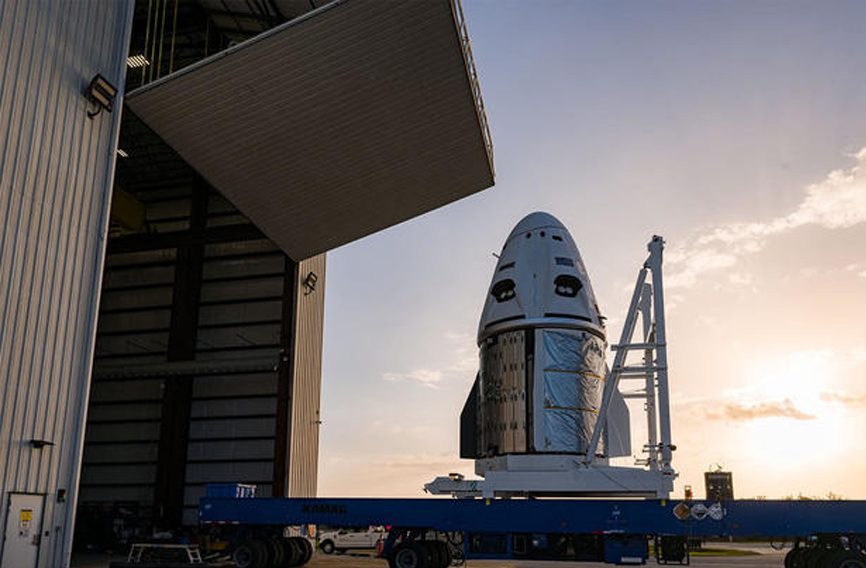NASA, Four astronauts are leaving the International Space Station after a five-month mission. To replace them, two NASA astronauts, a Russian cosmonaut, and an Emirati from the United Arab Emirates flew to the Kennedy Space Center on Tuesday to start getting ready for Monday’s launch on a SpaceX Crew Dragon flight.
The original launch date was Sunday, but managers at NASA and SpaceX asked for a 24-hour delay during a flight readiness review on Tuesday so that they could finish a few technical details. The new launch time is Monday at 1:45 a.m. EST.
Steve Stich, who is in charge of NASA’s commercial crew programmed, says that unfinished business will be taken care of by the end of the week.
“When we looked at the work that still needs to be done on the vehicle, like getting Dragon and Falcon 9 ready to go, we saw that we were a little bit behind, so we need a little bit more time to get it done,” he told reporters after the evaluation was done.
We’re taking our time at every step, making sure that Dragon is ready to launch, doing the necessary analysis, and getting Falcon 9 ready for liftoff.
On Tuesday, a Russian Soyuz rocket and a ship to carry the crew were brought to the launch pad at Kazakhstan’s Baikonur Cosmodrome. This makes it possible for the rocket to take off for the lab facility on Thursday evening.
After six months on the space station, NASA astronaut Frank Rubio, Russian cosmonaut Sergey Prokopyev, and Russian cosmonaut Dmitri Petelin were set to come back to Earth next month. On December 14, however, what is thought to have been a micrometeoroid hit their Soyuz MS-22 ferry spacecraft and broke a vital coolant line, making it useless.
Russians plan to launch an unmanned Soyuz MS-23 replacement craft on Thursday at 7:24 p.m. ET to bring Prokopyev, Petelin, and Rubio back to Earth in September, almost a year after they left. On the next Soyuz launch, the crew from MS-23 will take their place.
If Thursday’s launch goes well, the Soyuz MS-23 spacecraft will find the space station on its own and dock with the upper Poisk module of the station around 8 p.m. Saturday.
Monday morning, both SpaceX and NASA will be getting ready to launch the Crew Dragon spacecraft on a Falcon 9 rocket from pad 39A.
The ship’s crew of commander Stephen Bowen, pilot Warren “Woody” Hoburg, cosmonaut Andrey Fedyaev, and United Arab Emirates flyer Sultan Alneyadi landed at the spaceport’s 3-mile-long Launch and Landing Facility runway a few minutes before 12:30 p.m. on Tuesday to make the last preparations.
Bowen, who used to be a submariner and has been on three shuttle missions, told reporters on the runway, “I’ve had the chance to train with a great team over the past couple of years.” “In one word, they are wonderful people. Also, being here is a great honour. In short, we can’t wait to begin this project.”
SpaceX hopes to move the Falcon 9 rocket and Crew Dragon from the company’s hangar to the top of pad 39A on Wednesday. On Thursday night, Bowen and his crew will put on pressure suits and strap themselves in for a practise countdown that will end with a fake launch early Friday morning.
Engineers at SpaceX plan to test fire the Falcon 9’s first stage engines on Sunday night, after the crew has left. This will clear the way for the launch on Monday. If everything goes as planned, the Crew Dragon will arrive at the space station early Tuesday morning and dock to the upper port of the Harmony module at 2:29 a.m.
Captain Nicole Mann, Flight Engineer Josh Cassada, Japanese Astronaut Koichi Wakata, and Russian Cosmonaut Anna Kikina, along with Prokopyev, Petelin, and Rubio, will be waiting for Bowen and his crew to arrive.
In September, Prokopyev and the rest of his crew left for the station, where they planned to stay for a total of six months. But in December, a major leak of coolant is thought to have been caused by a micrometeoroid.
After a thorough check, Russian engineers decided that the spaceship couldn’t be trusted to bring the three crew members back to Earth without getting too hot. Because the MS-22 ferry ship was damaged, engineers worked quickly to get the Soyuz MS-23 ready to fly.
Two months after the Soyuz disaster, on February 11, the coolant in a Russian Progress cargo ship that was docked at the station suddenly ran out. After undocking last Friday, the Progress spacecraft went back into Earth’s atmosphere on Saturday and broke up over the southern Pacific.
After undocking, pictures and videos showed what the Russians think is the site of a leak caused by a problem with the launch or another hit, similar to the one that broke the Soyuz MS-22 spacecraft but bigger.
No matter what happened to Progress, Soyuz will come to the same port to replace it. When that time comes, both the Crew Dragon and the Soyuz will be available to the station’s crew in case of an emergency that needs them to leave quickly.
